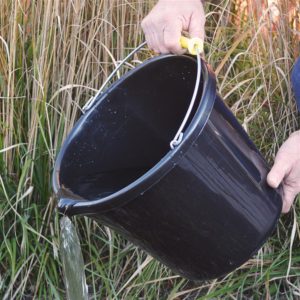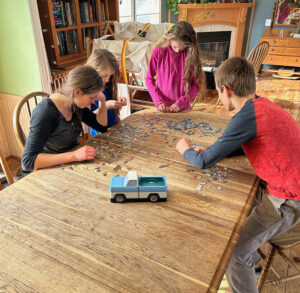You may think that you can only hunt wildlife in the woods. But in late spring, the season for another kind of hunting … morel hunting!
Unseasonably warm temperatures in many areas have started a phenomenon: morel mushrooms are literally popping up ahead of schedule in woodlands all over.
 Recently, my brother-in-law and I hiked half an hour to a shady, north-facing ridge  near my Midwest home. We began combing the area for morels.
Recently, my brother-in-law and I hiked half an hour to a shady, north-facing ridge  near my Midwest home. We began combing the area for morels.
It only took a couple minutes of intense walking and looking before he called out that he’d found two. Where you find one morel you’ll almost always find more.
Within about 10 minutes we had half a bag full, some 66 mushrooms ranging from about three to five inches tall. Although the uphill walk back to the truck was a real workout for a middle-aged big guy on a unnaturally hot early April morning–bring a walking stick–the reward came at supper time.
Morels are often considered the “lord of the forest,†the rare rock stars of the fungi world. They carry the same level of notoriety and popularity in much of the United States and many other countries as truffles do in Europe.
Like so many delicious foods, morels are only available for a short season. Although appearance is dependent on geography, morels can be found between March and May. Where I live in the Midwest in a typical summer it’s rare to find them before mid-April. By early June they’re usually done for the year. They pop up out of the ground in the first warm days following winter, often immediately after a rain shower.
Edible mushrooms, morels are the above ground “fruit†of an underground network of mycelium, a branching network of runners on thread-like roots.
So, how do you find the tasty offspring of these invisible roots? Look in moist areas near dead or dying elm, sycamore or ash trees. The mushrooms can be found on any moist slope in early season, but late in spring, may only be on a north-facing hillside that receives little direct sunlight.
Regardless of where you find morels, you’re likely to find them in the same area season after season. Mushroom hunters can be very secretive about their “honey hole†hunting locations. I’ve heard stories of old-timers blindfolding friends or relatives before driving them to a good morel hunting spot.
Once in the woods you have to know beyond a doubt what you’re looking for. While a good morel mushroom can be a joy to eat, a similar-looking imposter – sometimes called “false morels†– can be downright deadly.
It’s always best to go with a veteran mushroom hunter to learn exactly what you’re looking for and what to avoid.
 A true morel will have a hollow shaft topped by a triangular “sponge-like†hood with definite ridges and pits, not just a rough puffy exterior that resembles a small brain. When sliced open lengthwise it will be obvious that the hood is connected to the shaft from the tip all the way to the base of the hood.
A true morel will have a hollow shaft topped by a triangular “sponge-like†hood with definite ridges and pits, not just a rough puffy exterior that resembles a small brain. When sliced open lengthwise it will be obvious that the hood is connected to the shaft from the tip all the way to the base of the hood.
Morels are often tan in color, but can be more black, red or gray. Once you’ve located a morel, gently snap or cut the shaft at the ground level. A small paring or folding knife works well.
It’s a good practice to gently tap the mushroom on the ground near where you removed it. This jars loose any available spores and sends into the soil to grow. As you harvest morels, scan the nearby forest floor. You’ll be amazed how other morels will suddenly be visible as your eyes focus in on the prize.
Carry your morels in a perforated or mesh bag, which allows loose spores to fall out and drop on the soil where they are likely to thrive. A fruit press bag works well, as does an onion sack or mesh laundry bag. Avoid placing mushrooms in a plastic carrier or bag since their natural dampness makes them prone to developing harmful mold.
Once home, rinse morels in a crock or large bowl of saltwater. They’ll inevitably have ants, centipedes and other critters wandering through the folds of the caps and sometimes even inside the stems. Leave mushrooms in the first bowl of salted water for about 20 minutes, then dump the dirty water and refill with fresh salted water and let soak 30 more minutes.
After the final soak, slice each mushroom with a paring knife up the middle from the cap to the base of the stem. I usually put my cut morels in a clean bowl of cool salted water and pop that into the refrigerator until suppertime.
 I usually skillet-fry my morels. First, I heat a skillet of cooking oil, poured deep enough float the morels. Then, I mix an egg and milk well in a small deep bowl. A second shallow bowl holds a mixture of all-purpose flour and seasonings. I’ve found that fish seasonings are a tasty option with morels.
I usually skillet-fry my morels. First, I heat a skillet of cooking oil, poured deep enough float the morels. Then, I mix an egg and milk well in a small deep bowl. A second shallow bowl holds a mixture of all-purpose flour and seasonings. I’ve found that fish seasonings are a tasty option with morels.
Make sure you lay out the morels on a paper towel and pat them dry so the flour will adhere, and the frying oil won’t splash up at you.
Dip each morel piece into the milk-egg solution and then roll them in the seasoned flour, and drop carefully into the hot oil.
Turn each piece once once after a minute or so to form a light golden crust on both sides. Remove them from the oil one minute after turning. Cool briefly on a towel-lined bowl or baking sheet.
 What you’ll taste will be a nutty, acorn, earthy (in a good way) mushroom that is considered by many to be a culinary delicacy and a dining delight. Because of their finicky nature, farm producing morels in mass quantities is difficult to do, which keeps the odd-looking little edible fungi somewhat of a rarity and a seasonal treat.
What you’ll taste will be a nutty, acorn, earthy (in a good way) mushroom that is considered by many to be a culinary delicacy and a dining delight. Because of their finicky nature, farm producing morels in mass quantities is difficult to do, which keeps the odd-looking little edible fungi somewhat of a rarity and a seasonal treat.

































